Chapter 1: Java Basics
5.0(2)
5.0(2)
Card Sorting
1/49
Earn XP
Description and Tags
- Define the scope of variables - Define the structure of a Java class - Create executable Java applications with a main method; run a Java program from the command line; produce console output - Import other Java packages to make them accessible in your code - Compare and contrast the features and components of Java such as: platform independence, object orientation, encapsulation, etc.
Study Analytics
Name | Mastery | Learn | Test | Matching | Spaced |
|---|
No study sessions yet.
50 Terms
1
New cards

D. An entry point in a Java application consists of a main() method with a single String\[\] argument, return type of void, and modifiers public and static. The name of the variable in the input argument does not matter. Option A is missing the static modifier, Option B is missing the String\[\] argument, and Option C has the wrong access modifier and method name. Only Option D fulfills these requirements. Note that the modifier final is optional and may be added to an entry point method.
2
New cards
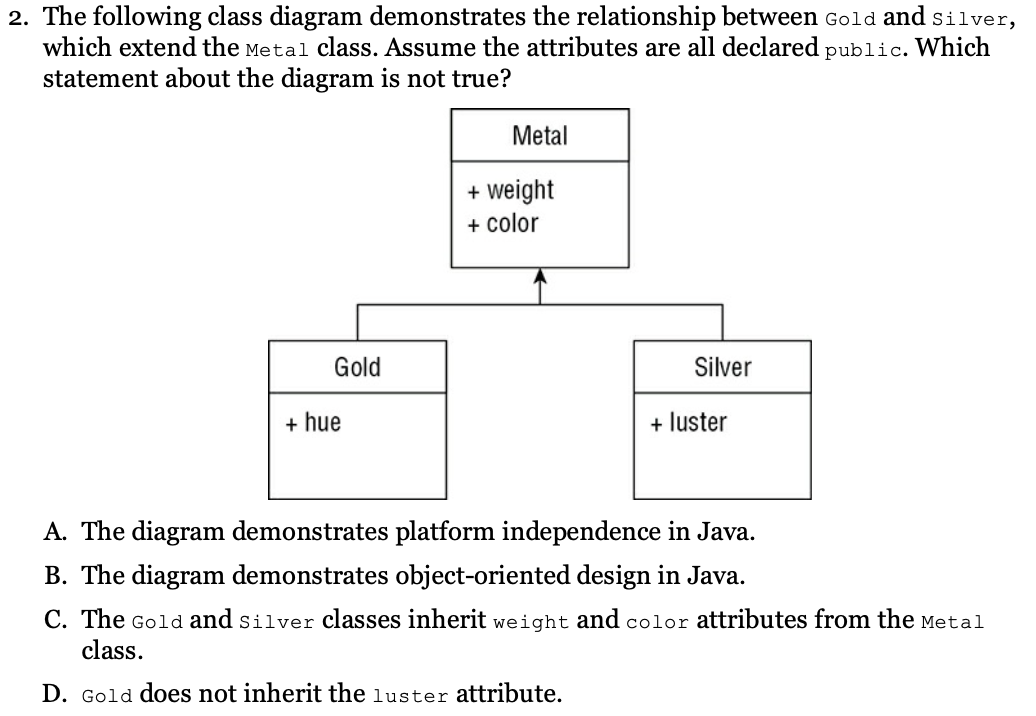
A. The diagram is an example of object-oriented design in Java, making Option B a true statement. Options C and D are also true, as they follow from the inheritance model in the diagram. Option A is the correct answer, since platform independence has nothing to do with the diagram.
3
New cards

C.The proper extension for a Java compiled byte code file is .class, making Option C the correct answer.
4
New cards

B. The fact that the Date class exists in both packages does not impact the ability to import both packages, so lines 1 and 2 compile without issue, and Option A is incorrect. Line 4 will not compile because the Date class used is ambiguous, making Option B correct and Option D incorrect. Finally, Option C is incorrect because line 5 does compile, as the fully qualified name of the class is used.
5
New cards

A. Options B, C, and D are each attributes of traditional object-oriented programming. Option A is incorrect as an object-oriented project tends to group data and the actions related to that data into a single object.
6
New cards
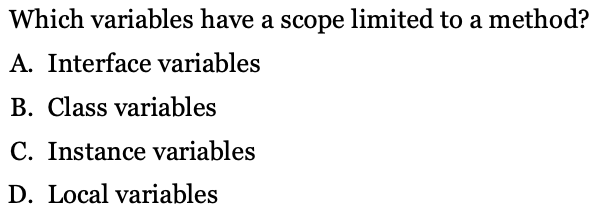
D. Only local variables have such a small scope, making Option D the correct answer.
7
New cards

B. The package java.lang is imported into every Java class, so Option B is correct. The other options must be explicitly imported. Option A exists but must be explicitly imported. Options C and D do not exist in the standard Java runtime.
8
New cards

C. Java accepts Options A, B, and D as valid comments. Note that the /\*\*/ syntax can have additional (and uneven) star (\*) characters as shown in B and D. Option C is incorrect as hashtag (#) is not a valid comment character in Java.
9
New cards

D. A valid .java file may define any number of classes or interfaces but have at most one public class. It can also not define any public classes. For these reasons, Option A, B, and C are incorrect, leaving Option D as the only correct answer.
10
New cards
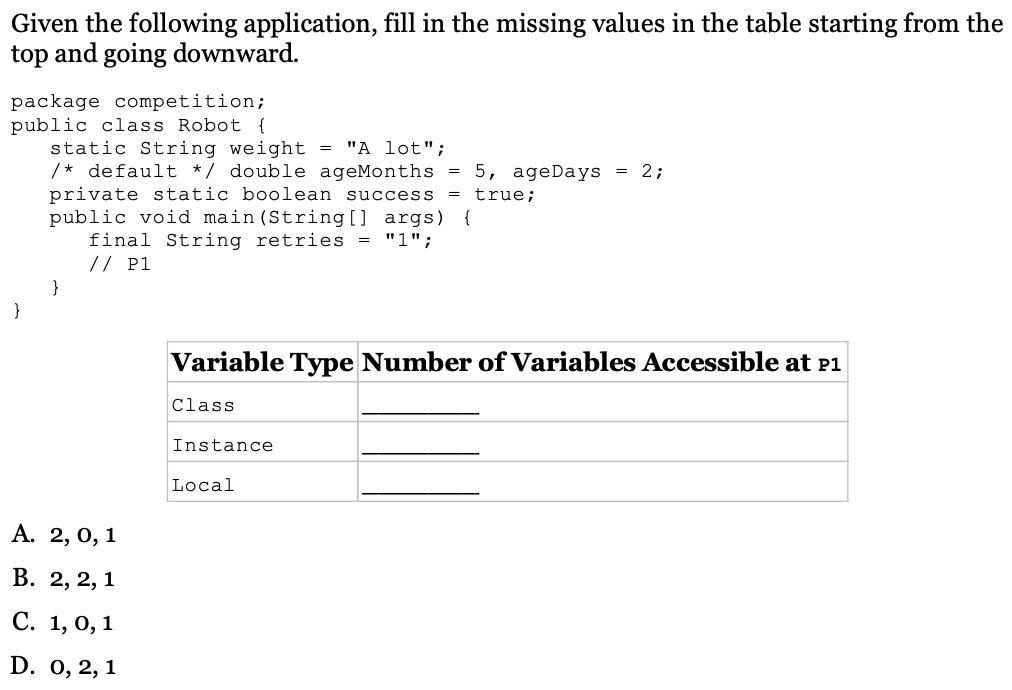
B. Notice in this question that main() is not a static method, therefore it can access both class and instance variables. Since there are two class variables and two instance variables defined, Option B is the correct answer.
11
New cards

B. A class will compile if it has unused or redundant import statements, making Option A and C incorrect. Option D is also incorrect as the compiler must be able to locate the class of the import statement. The correct answer is Option B. Removing unused import statements does not cause a class to become unable to be compiled.
12
New cards
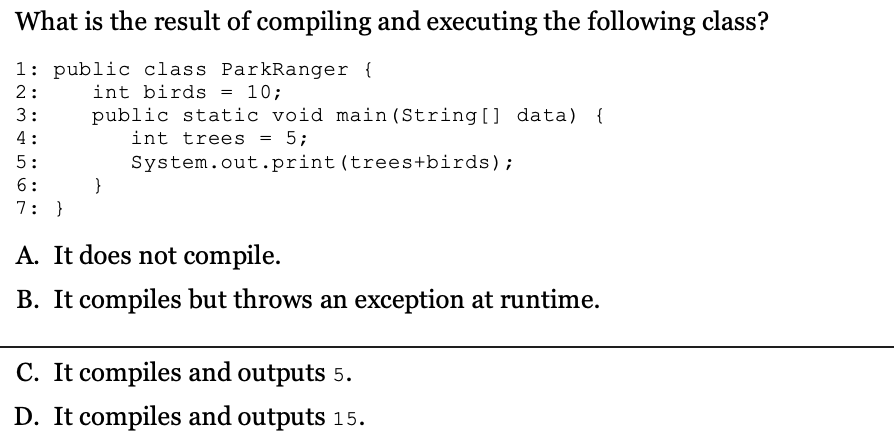
A. The code does not compile because of line 5, making Option A the correct answer. For this question, it helps to understand variable scope. The main() method is static and does not have access to any class instance variables. The birds variable is not static and requires a class instance variable to access. Therefore, the code does not compile when the static method attempts to access a non-static variable without an instance of the class.
13
New cards
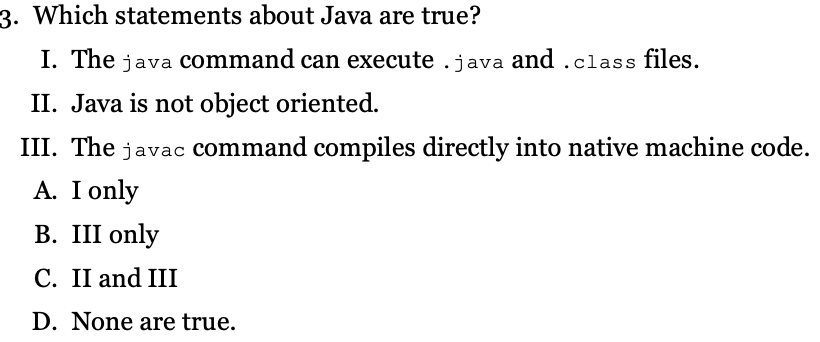
D. The java command can only execute compiled .class files, so is most certainly object oriented, one of the key design principles, so II is also false. Java is most certainly object oriented, one of the key design principles, so II is also false. The javac command compiles into bytecode, which must be run in a Java virtual machine (JVM), and is not native machine code, so III is false as well. Since none of the statements are true, Option D is the correct answer.
14
New cards

D. A class can start with a comment, an optional package statement, or an import statement if there is no package statement. It cannot start with a variable definition, making Option D the correct answer.
15
New cards

C. Classes may be defined without a package declaration and are placed in the default package, so Option A is incorrect. Option B is a completely false statement as no such file is required in Java. Option C is correct as it is one of the primary reasons for organizing your application into packages. Option D is incorrect as package-private allows access to methods and variables to be limited to those classes within the same package.
16
New cards
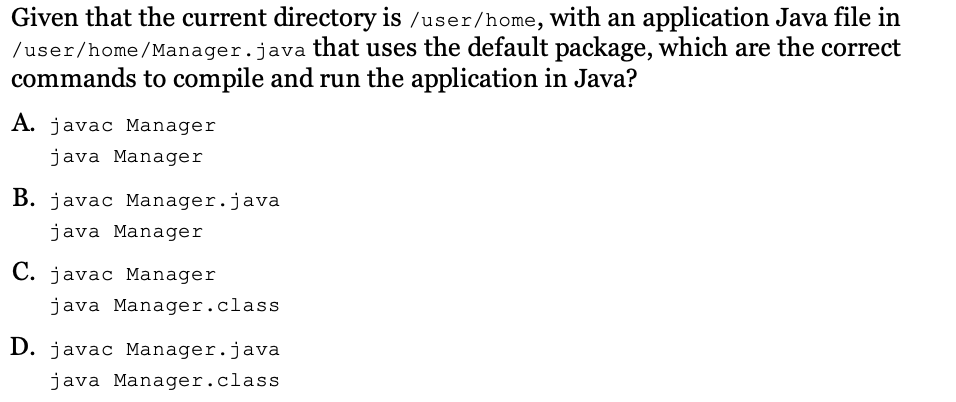
B. The compilation command requires the full or relative name of the file, including the .java extension, making Options A and C incorrect. The execution command requires the class name without a filename extension, making Option D incorrect. Option B is the only correct set of compilation and execution commands.
17
New cards

1. D. Encapsulation is the technique of removing access to a class’s instance variables from processes outside the class, making Option D the correct answer.
18
New cards
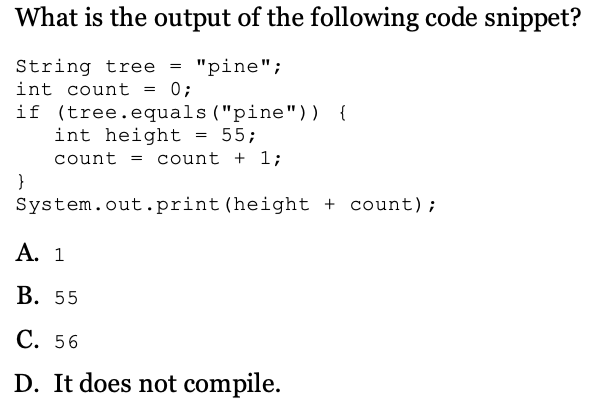
D. The height variable is declared within the if-then statement block. Therefore, it cannot be referenced outside the if-then statement and the code does not compile.
19
New cards

A. A Java bytecode file is a binary encoded set of instructions designed to be run on any computer with a compatible JVM, making Option A the only correct answer. By compatible JVM, we mean one capable of running the class file. For example, a Java 6 JVM may have trouble executing a Java 8 compiled file. Option B is incorrect, and is more a facet of machine language compiled programming classes. Option C is also incorrect as binary data is not particularly human readable. Finally, Option D is incorrect as the compiled file can be distributed without its .java source file and execute without issue.
20
New cards

D. Unlike with some other programming languages, the proper way to terminate a line of code is with a semicolon (;), making D the only correct answer.
21
New cards
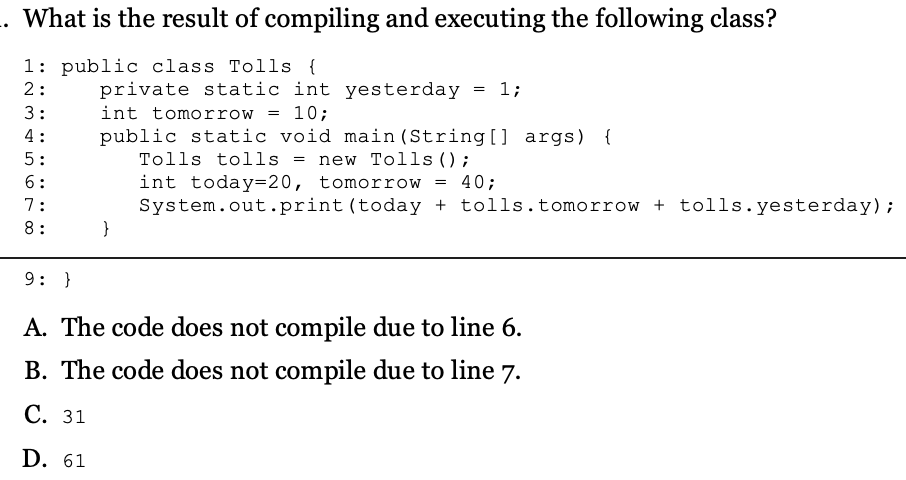
C. The code compiles and runs without issue, so Options A and B are incorrect. The question relies on your ability to understand variable scope. The variable today has local scope to the method in which it is executed. The variable tomorrow is re-declared in the method, but the reference used on line 7 is to the instance variable with a value of 10. Finally, the variable tomorrow is static. While using an instance reference to access a static variable is not recommended, it does not prevent the variable from being read. The result is line 7 evaluates and prints (20 + 10 + 1) = 31, making C the correct answer.
22
New cards
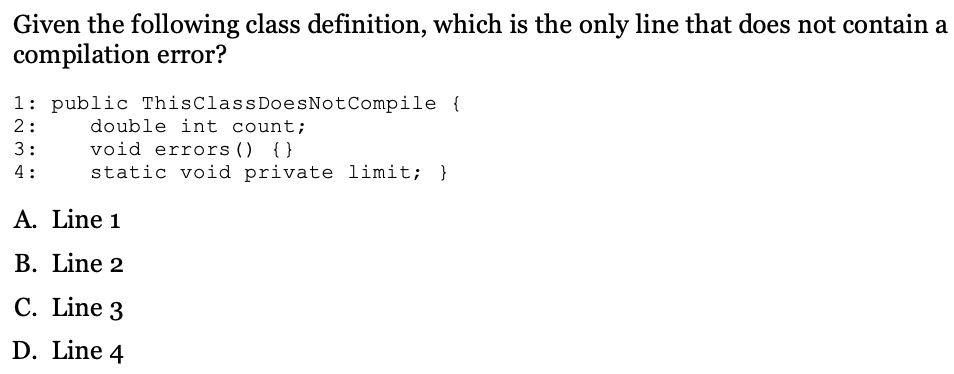
C. Line 1 is missing the class keyword. Line 2 contains two types for the same variable. Line 3 is a valid definition for a method, making C the correct answer. Finally, line 4 contains an access modifier, private, after the return type, which is not allowed. In addition, void is an invalid type for variables.
23
New cards

D. Platform independence is the property of Java that allows it to be run on a variety of different devices.
24
New cards

A. Options B, C, and D are each correct statements about JVMs. Option A is incorrect. Not only is it not a statement about JVMs, it is actually false as Java bytecode can often be easily decoded/decompiled.
25
New cards

B. There is no such thing as package variables, so Option A is incorrect. Option C is incorrect as the variable is only in scope within a specific instance of the class. Option D is also incorrect as the variable is only in scope for a single method that it is defined in. Option B is the only correct answer as class variables are in scope within the program.
26
New cards

C. Option A is incorrect as the sub-package recurring is not included by the import statements. Option B is also incorrect as it uses the plural directors instead of the singular director used in the import statements. Option D is incorrect as the wildcard is applied to the sub-package movie.director, not the package movie. Finally, Option C is correct as it is a valid class accessible from the wildcard import.
27
New cards

D. Java classes are defined in this order: package statement, import statements, class declaration, making Option D the only correct answer. Note that not all of these statements are required. For example, a class may not have a package statement, but if it does, it must come first in the file.
28
New cards
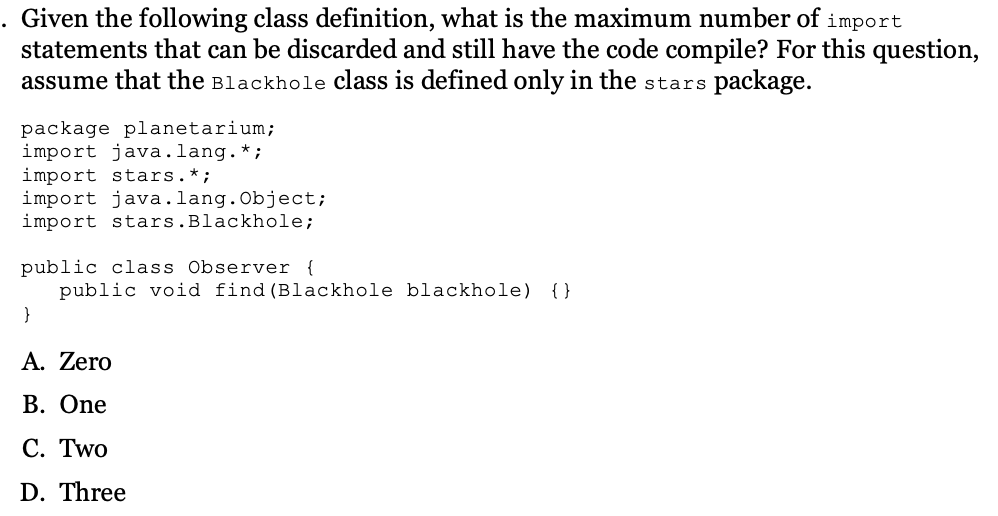
D. The import statements for stars. \*and stars. Black hole are redundant import statements, since only the class Blackhole is used, and therefore one of them can be safely removed. The import statements java.lang.\* and java.lang.Object are both not required as java.lang is automatically imported in every Java class. Therefore, three of the four import statements can be safely removed, making the correct answer Option D.
29
New cards
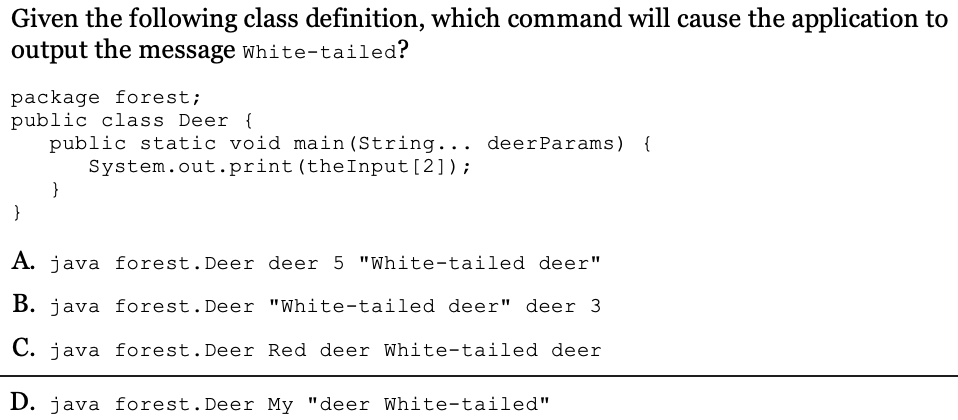
1. C. The application prints the third argument of the input methods. Note that double quotes "" group input arguments. Therefore, the third argument of Option A is White- tailed deer. The third argument of Option B is 3. The third argument of Option C is White-tailed, making it the correct answer. Finally, Option D only has two input arguments, leading to an ArrayIndexOutOfBoundsException trying to read the third argument at runtime.
30
New cards

B. The javac command compiles a .java file into a .class bytecode file, making Option B the correct answer.
31
New cards
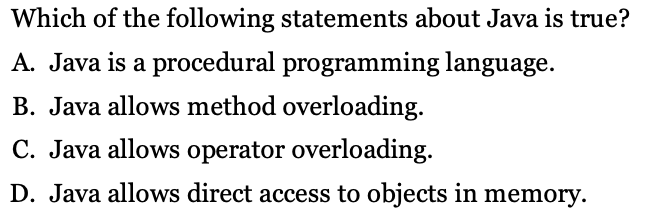
B. Java is object oriented, not procedural, so Option A is a false statement. Java allows method overloading in subclasses, so Option B is correct. Operator overloading is permitted in languages like C++, not Java, so Option C is also untrue. Finally, Option D is not a true statement as the JVM manages the location of objects in memory that can change and is transparent to the Java application.
32
New cards
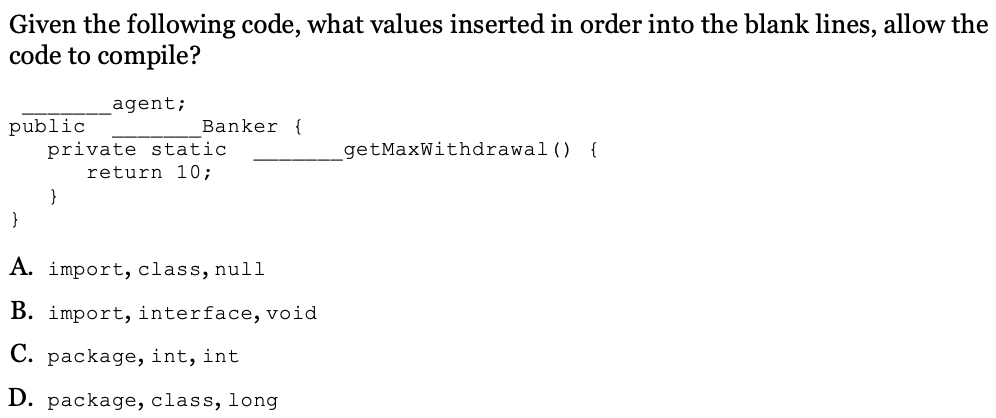
D. Option A is incorrect as the return type of the method cannot be null. Option B is also incorrect as the return type cannot be void if the method uses a return statement. Option C is incorrect too as the class keyword is replaced with int. Option D is correct because it’s the only answer that allows the code to compile without issue. Note that other values are possible for this question. For example, either int or long can be entered in the last blank. The key here is that only one of the available answer choices allows the code to compile.
33
New cards
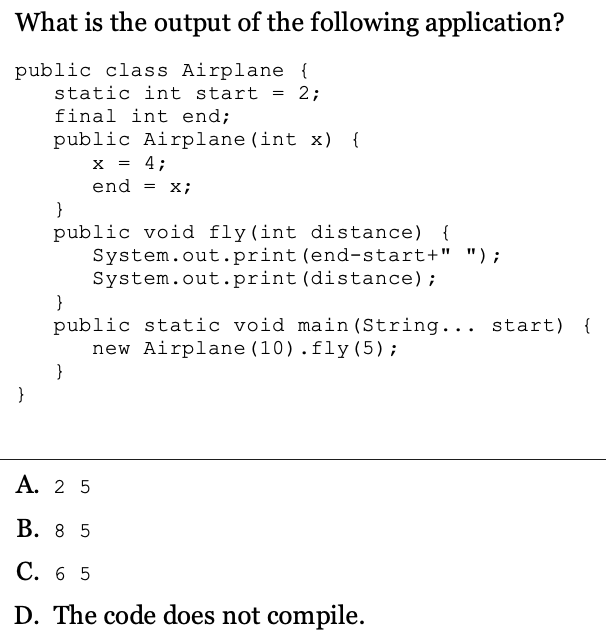
1. A. The code compiles so Option D is incorrect. The input to the constructor is ignored, making the assignment of end to be 4. Since start is 2, the subtraction of 4 by 2 results in the application printing 2, followed by 5, making Option A the correct answer.
34
New cards
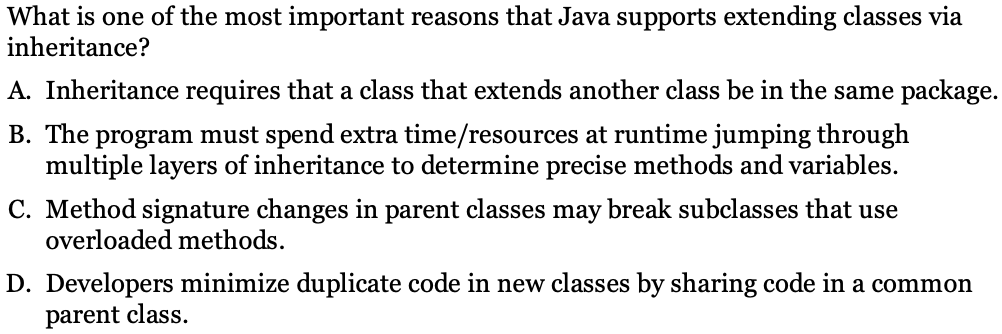
D. Option A is a false statement, while Options B and C are actually arguments against using inheritance. Option D is one of the most important reasons Java supports inheritance, to allow increased code reuse among classes.
35
New cards

A. The double slash (//) syntax can have any number of slashes as a comment, so long as it starts with two of them, making Option A the correct answer. The (#) is not a comment character in Java, regardless of whether it is followed by a (!), so Option B is incorrect. Option C is incorrect as a single slash (/) is not a valid comment in Java. Finally, Option D is incorrect as Option A is a valid comment.
36
New cards

B. An entry point in a Java application consists of a main() method with a single String\[\] argument, return type of void, and modifiers public and static. Option D is the typical syntax for this method, although Options A and C are also valid forms of this method. Note that the modifier final is optional and may be added to the method signature. Furthermore, the main() method may take a var arg or array. Option B is the only invalid declaration as it does not take an array as an argument.
37
New cards
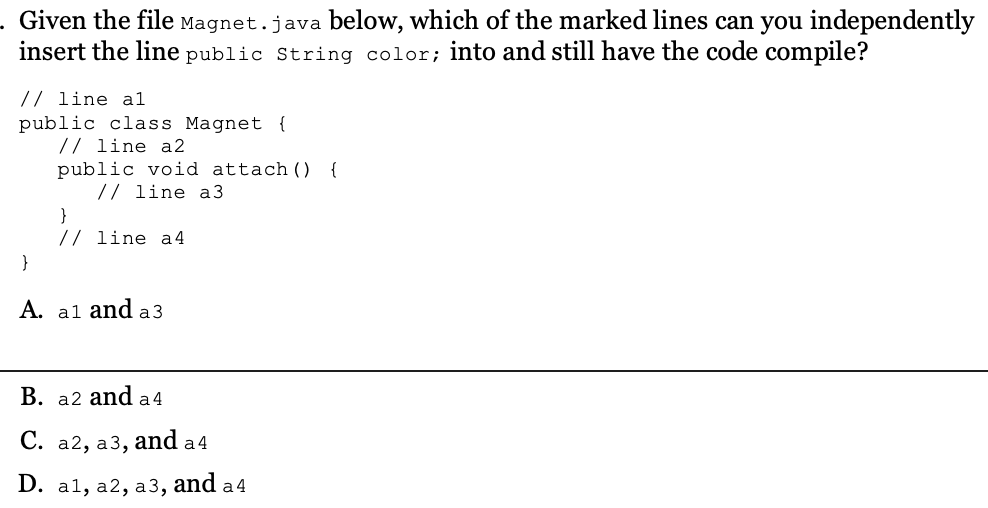
B. The line of code cannot be inserted at a1 because no variables are allowed outside of the class declaration in this file, making Options A and D incorrect. The line of code can also not be inserted at a3 as local variables defined within methods cannot have access modifiers such as public, making Option C incorrect. The code can be inserted independently at a2 and a4 as instance variables can be defined anywhere in the class outside a method. Therefore, Option B is the correct choice.
38
New cards
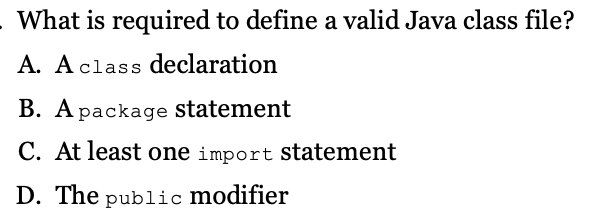
A. Option A is the only correct answer as a class definition is the only required component in a Java class file. Note that we said a Java class file here; Java also allows interfaces and enums to be defined in a file. A package statement and import statements are optional for declaring a class, making Options B and C incorrect. A class may also be defined with package-level access in a file, making Option D an incorrect answer.
39
New cards

D. The proper extension for a Java compiled bytecode file is .java, making Option D the correct answer.
40
New cards
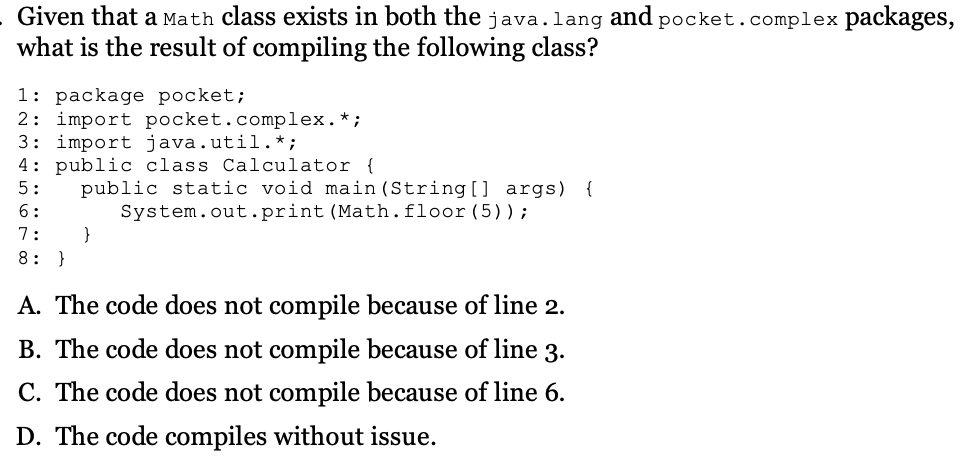
C. Remember that java.lang is automatically imported in all Java classes, therefore both java.lang.Math and pocket.complex.Math are both imported into this class. Importing both sets of packages does not cause any compilation issues, making Option A incorrect. Line 3 is unnecessary import but including it does not prevent the class from compiling, making Option B incorrect. While both versions of Math may be imported into the class, the usage of the Math class requires a package name. Because of this, line 6 does not compile as the class reference is ambiguous, making Option C the correct answer and Option D incorrect.
41
New cards

A. Options B and C are accessible within the class as they are covered by the import statements. Option D is also fine as java.lang.Object is available without an explicit import. The only class not automatically accessible within the class without the full package name is dog.puppy.female.KC as the import statements do not include sub- packages; therefore, Option A is the correct answer.
42
New cards

B. Object-oriented programming is the technique of structuring data into objects, which may contain data and a set of actions that operate on the data, making Option B the correct answer.
43
New cards
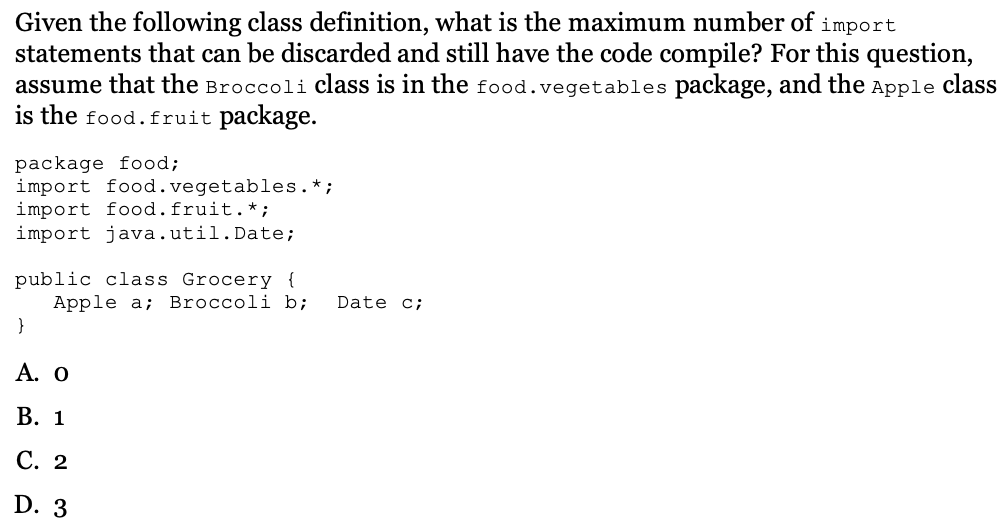
A. All of the import statements in this class are required. Removing any of them would cause the class to not compile, making Option A the correct answer.
44
New cards
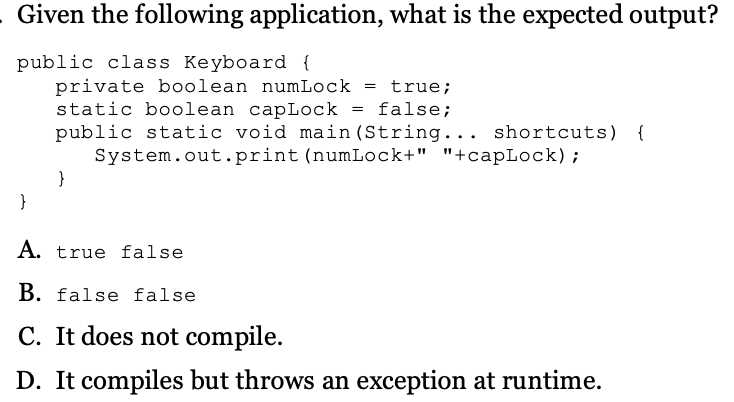
C. The numLock variable is not accessible in the static main() method without an instance of the Keyboard class; therefore, the code does not compile, and Option C is the correct answer.
45
New cards
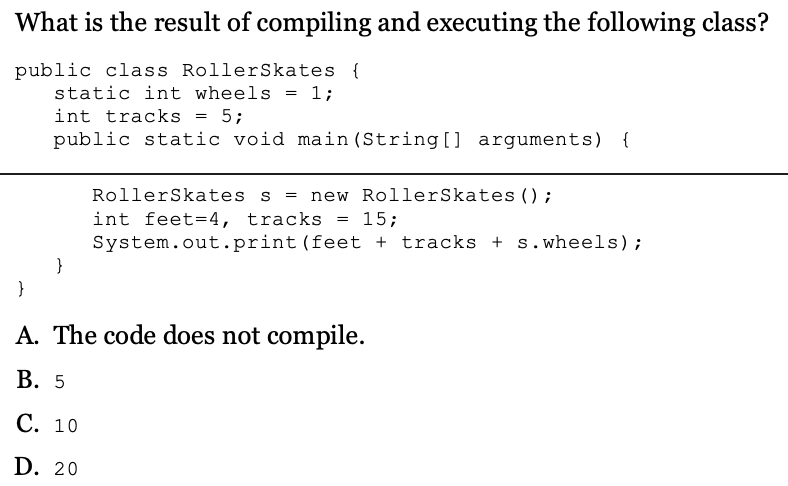
D. The code compiles and runs without issue, so Option A is incorrect. The question involves understanding the value and scope of each variable at the print() statement. The variables feet and tracks are locally scoped and set to 4 and 15, respectively, ignoring the value of tracks of 5 in the instance of the class. Finally, the static variable s.wheels has a value of 1. The result is the combined value is 20, making Option D the correct answer.
46
New cards
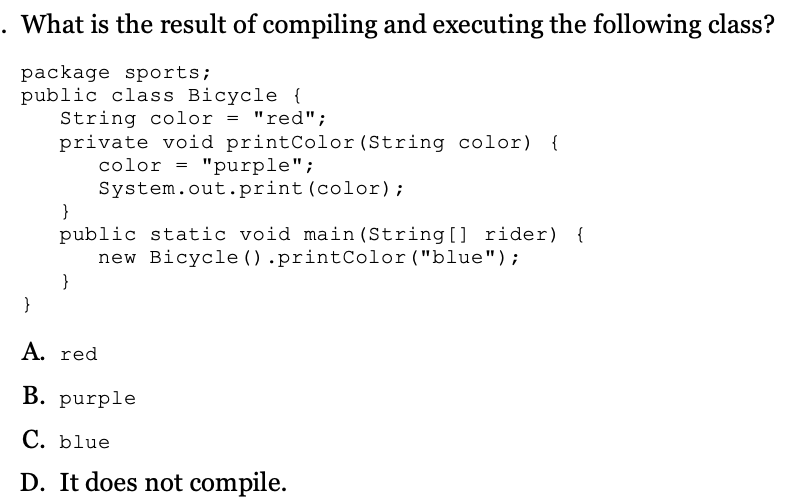
B. First off, the color variable defined in the instance and set to red is ignored in the method printColor() as local scope overrides instance scope, so Option A is incorrect. The value of color passed to the printColor() method is blue, but that is lost by the assignment to purple, making Option B the correct answer and Option C incorrect. Option D is incorrect as the code compiles and runs without issue.
47
New cards
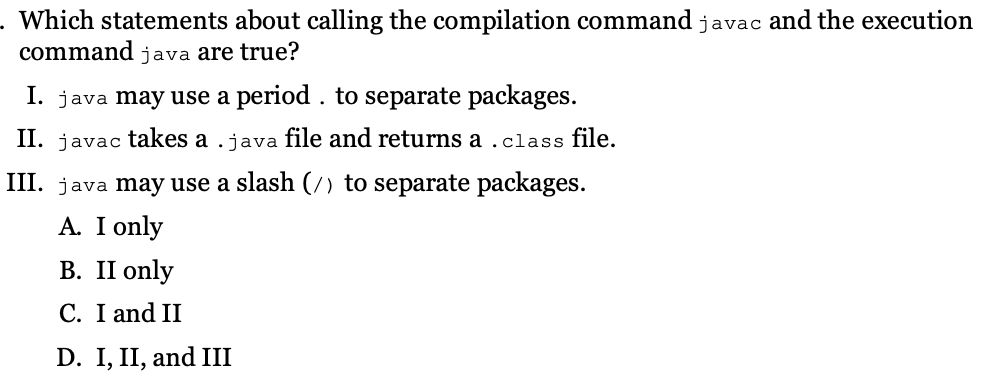
C. The javac command takes a text-based .java file and returns a binary bytecode .class file, making II a true statement. The java command uses a period (.) to separate packages, not a slash (/), making I a true statement and III a false statement. For these reasons, Option C is the correct answer.
48
New cards
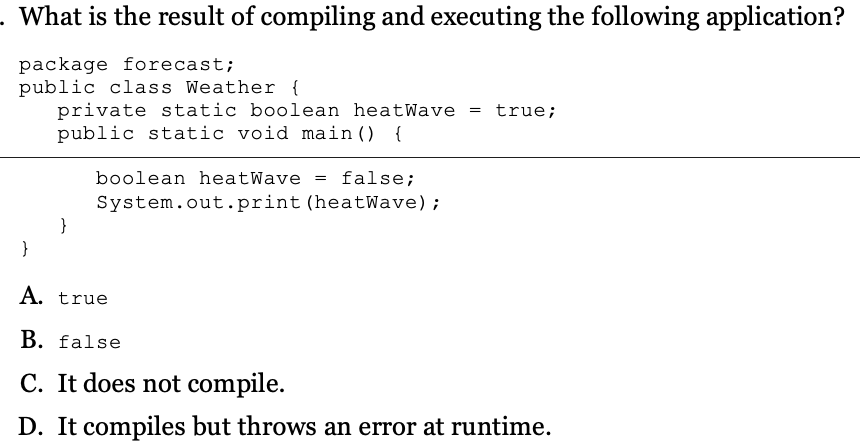
1. D. The application compiles without issue, so Option C is incorrect. The application does not execute though, as the main() method does not have the correct method signature. It is missing the required input argument, an array of String. Trying to execute the application without a proper entry point produces an error, making Option D the correct answer.
49
New cards
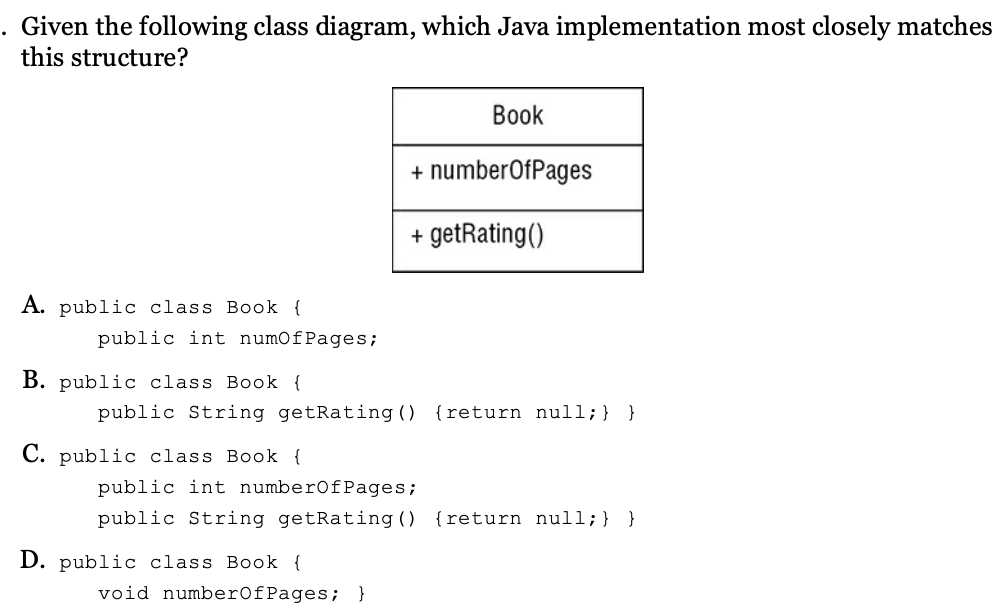
C. Option A does not compile because it is missing the closing bracket for the class. Option D does also not compile as void is not a valid type for a variable. Regardless, Options A and D are incorrect as they are missing the getRating() method. Note that Option A also uses an abbreviation for numberOfPages. Option B is incorrect as it is missing the numberOfPages attribute. Option C is the correct answer as it properly defines the attribute numberOfPages and method getRating().
50
New cards

1. C. Garbage collection can happen at any time while an application is running, especially if the available memory suddenly becomes low, making Option A incorrect. Option B is also incorrect, since it is trivial to create a Java application with an infinite loop that never terminates. Option D is incorrect because the computer must be able to run the JVM in order to execute a Java class. Option C is the only correct answer, as the JVM does require an entry point method to begin executing the application.